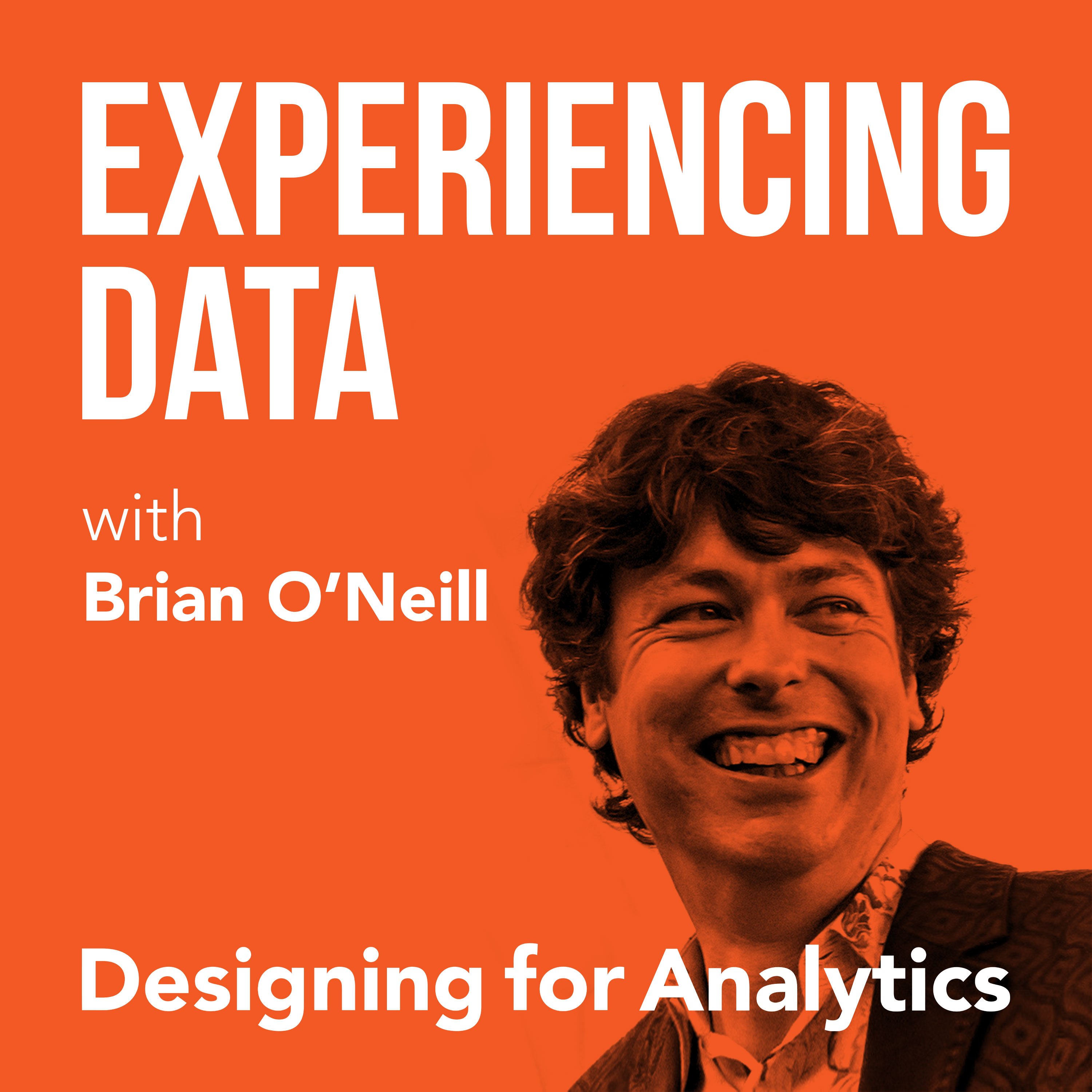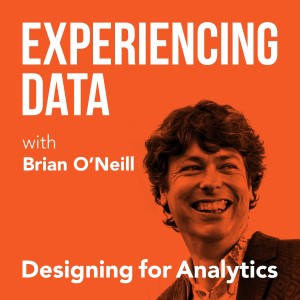

154.7K
Downloads
185
Episodes
Is the value of your enterprise analytics SAAS or AI product not obvious through it’s UI/UX? Got the data and ML models right...but user adoption of your dashboards and UI isn’t what you hoped it would be?
While it is easier than ever to create AI and analytics solutions from a technology perspective, do you find as a founder or product leader that getting users to use and buyers to buy seems harder than it should be?
If you lead an internal enterprise data team, have you heard that a ”data product” approach can help—but you’re concerned it’s all hype?
My name is Brian T. O’Neill, and on Experiencing Data—one of the top 2% of podcasts in the world—I share the stories of leaders who are leveraging product and UX design to make SAAS analytics, AI applications, and internal data products indispensable to their customers. After all, you can’t create business value with data if the humans in the loop can’t or won’t use your solutions.
Every 2 weeks, I release interviews with experts and impressive people I’ve met who are doing interesting work at the intersection of enterprise software product management, UX design, AI and analytics—work that you need to hear about and from whom I hope you can borrow strategies.
I also occasionally record solo episodes on applying UI/UX design strategies to data products—so you and your team can unlock financial value by making your users’ and customers’ lives better.
Hashtag: #ExperiencingData.
JOIN MY INSIGHTS LIST FOR 1-PAGE EPISODE SUMMARIES, TRANSCRIPTS, AND FREE UX STRATEGY TIPS
https://designingforanalytics.com/ed
ABOUT THE HOST, BRIAN T. O’NEILL:
https://designingforanalytics.com/bio/
Episodes

Tuesday Dec 14, 2021
Tuesday Dec 14, 2021
Finding it hard to know the value of your data products on the business or your end users? Do you struggle to understand the impact your data science, analytics, or product team is having on the people they serve?
Many times, the challenge comes down to figuring out WHAT to measure, and HOW. Clients, users, and customers often don’t even know what the right success or progress metrics are, let alone how to quantify them. Learning how to measure what might seem impossible is a highly valuable skill for leaders who want to track their progress with data—but it’s not all black and white. It’s not always about “more data,” and measurement is also not about “the finite, right answer.” Analytical minds, ready to embrace subjectivity and uncertainty in this episode!
In this insightful chat, Doug and I explore examples from his book, How to Measure Anything, and we discuss its applicability to the world of data and data products. From defining trust to identifying cognitive biases in qualitative research, Doug shares how he views the world in ways that we can actually measure. We also discuss the relationship between data and uncertainty, forecasting, and why people who are trying to measure something usually believe they have a lot less data than they really do.
Episode Description
- A discussion about measurement, defining “trust”, and why it is important to collect data in a systematic way. (01:35)
- Doug explores “concept, object and methods of measurement” - and why most people have more data than they realize when investigating questions. (09:29)
- Why asking the right questions is more important than “needing to be the expert” - and a look at cognitive biases. (16:46)
- The Dunning-Kruger effect and how it applies to the way people measure outcomes - and Bob discusses progress metrics vs success metrics and the illusion of cognition. (25:13)
- How one of the challenges with machine learning also creates valuable skepticism - and the three criteria for experience to convert into learning. (35:35)
Quotes from Today’s Episode
-
“Often things like trustworthiness or collaboration, or innovation, or any—all the squishy stuff, they sound hard to measure because they’re actually an umbrella term that bundles a bunch of different things together, and you have to unpack it to figure out what it is you’re talking about. It’s the beginning of all scientific inquiry is to figure out what your terms mean; what question are you even asking?”- Doug Hubbard (@hdr_frm) (02:33)
-
“Another interesting phenomenon about measurement in general and uncertainty, is that it’s in the cases where you have a lot of uncertainty when you don’t need many data points to greatly reduce it. [People] might assume that if [they] have a lot of uncertainty about something, that [they are] going to need a lot of data to offset that uncertainty. Mathematically speaking, just the opposite is true. The more uncertainty you have, the bigger uncertainty reduction you get from the first observation. In other words, if, you know almost nothing, almost anything will tell you something. That’s the way to think of it.”- Doug Hubbard (@hdr_frm) (07:05)
-
“I think one of the big takeaways there that I want my audience to hear is that if we start thinking about when we’re building these solutions, particularly analytics and decision support applications, instead of thinking about it as we’re trying to give the perfect answer here, or the model needs to be as accurate as possible, changing the framing to be, ‘if we went from something like a wild-ass guess, to maybe my experience and my intuition, to some level of data, what we’re doing here is we’re chipping away at the uncertainty, right?’ We’re not trying to go from zero to 100. Zero to 20 may be a substantial improvement if we can just get rid of some of that uncertainty, because no solution will ever predict the future perfectly, so let’s just try to reduce some of that uncertainty.”- Brian T. O’Neill (@rhythmspice) (08:40)
- “So, this is really important: [...] you have more data than you think, and you need less than you think. People just throw up their hands far too quickly when it comes to measurement problems. They just say, ‘Well, we don’t have enough data for that.’ Well, did you look? Tell me how much time you spent actually thinking about the problem or did you just give up too soon? [...] Assume there is a way to measure it, and the constraint is that you just haven’t thought of it yet. ”- Doug Hubbard (@hdr_frm) (15:37)
-
“I think people routinely believe they have a lot less data than they really do. They tend to believe that each situation is more unique than it really is [to the point] that you can’t extrapolate anything from prior observations. If that were really true, your experience means nothing.”- Doug Hubbard (@hdr_frm) (29:42)
- “When you have a lot of uncertainty, that’s exactly when you don’t need a lot of data to reduce it significantly. That’s the general rule of thumb here. [...] If what we’re trying to improve upon is just the subjective judgment of the stakeholders, all the research today—and by the way, here’s another area where there’s tons of data—there’s literally hundreds of studies where naive statistical models are compared to human experts […] and the consistent finding is that even naive statistical models outperform human experts in a surprising variety of fields.”- Doug Hubbard (@hdr_frm) (32:50)
Links Referenced
- How to Measure Anything: https://www.amazon.com/gp/product/1118539273/
- Hubbard Decision Research: https://hubbardresearch.com
No comments yet. Be the first to say something!